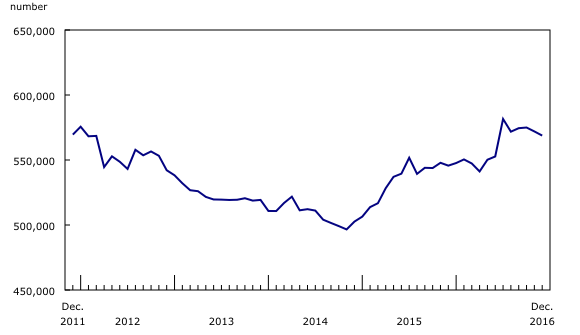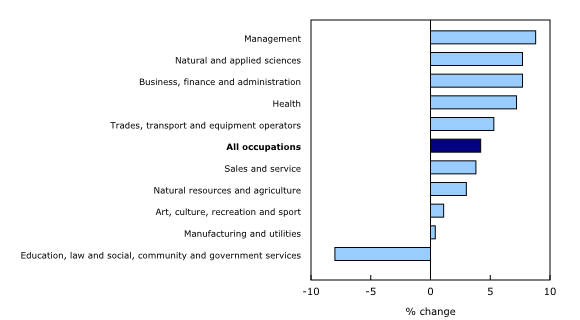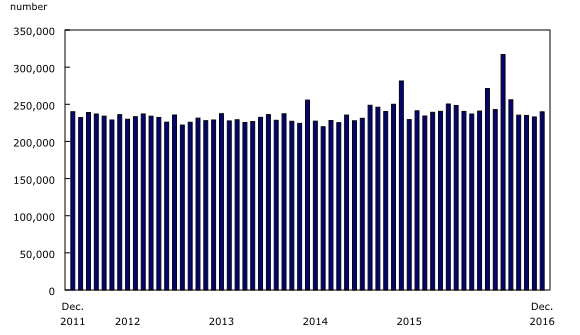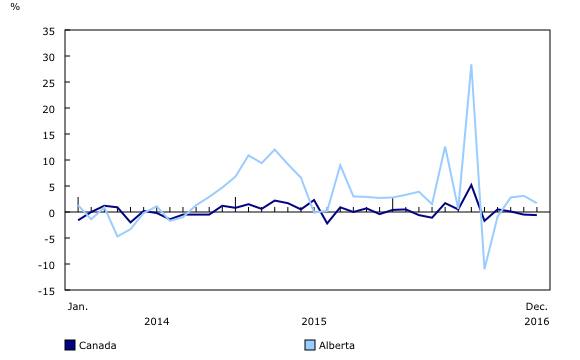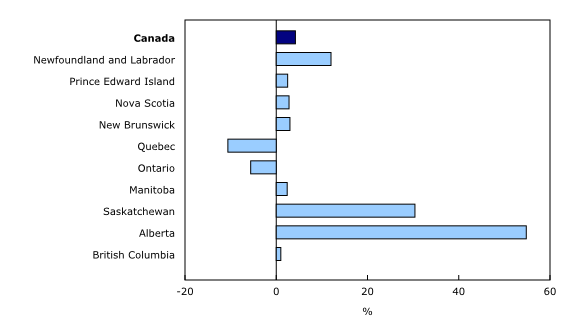Employment Insurance, December 2016
Archived Content
Information identified as archived is provided for reference, research or recordkeeping purposes. It is not subject to the Government of Canada Web Standards and has not been altered or updated since it was archived. Please "contact us" to request a format other than those available.
Released: 2017-02-16
In December, 568,800 people received regular Employment Insurance (EI) benefits, down slightly (-3,200 or -0.6%) from the previous month.
Provincially, Saskatchewan recorded the largest decrease in beneficiaries (-3.6%) in December. Smaller declines occurred in Quebec (-1.7%), British Columbia (-1.6%) and Prince Edward Island (-1.3%). Conversely, the number of beneficiaries increased in Alberta (+1.7%), while it was little changed in the other provinces.
In the 12 months to December, the number of EI beneficiaries in Canada was up by 23,100 or 4.2%, largely as a result of increases in Alberta.
In general, changes in the number of regular EI beneficiaries reflect various situations, including people becoming beneficiaries, those going back to work and those no longer receiving regular benefits.
In addition, part of the year-over-year increase in December may be related to EI policy changes, such as those that came into effect in July 2016. More information on the 2016 EI changes is available on Employment and Social Development Canada's website.
Provincial and sub-provincial overview
In Saskatchewan, 20,200 people received regular EI benefits in December, down 750 or 3.6% from November. Decreases occurred throughout the province, including the census metropolitan areas (CMAs) of Regina (-6.1%) and Saskatoon (-5.8%).
Building on employment gains in the second half of 2016, the number of beneficiaries in Quebec decreased in December for the fifth consecutive month, down 1.7% to 132,300. Most areas in the province recorded declines, including the CMAs of Trois-Rivières (-3.7%), Québec (-3.4%) and Montréal (-2.2%). On a year-over-year basis, the number of beneficiaries in the province of Quebec was down by 10.6%.
In British Columbia, 55,000 people received EI benefits in December, down 1.6% from November. While the number of beneficiaries in Kelowna was unchanged, the other three CMAs reported decreases: Abbotsford-Mission (-2.0%), Vancouver (-1.2%) and Victoria (-1.1%).
After four months of increases, the number of people receiving EI benefits in Prince Edward Island decreased 1.3% in December from the previous month to 7,800. Areas outside of census agglomerations (CAs) accounted for most of this decline.
In Alberta, the number of people receiving EI benefits rose for the third consecutive month in December, up 1,700 or 1.7% from the previous month to 97,900. Excluding July 2016, when changes to EI legislation took effect, this was the largest number of beneficiaries recorded in Alberta since the start of the series in 1997. Both the CMAs of Calgary (+4.1%) and Edmonton (+1.5%) reported increases in beneficiaries, as did some of the CAs. On the other hand, the number of beneficiaries in areas outside of CMAs and CAs decreased by 1.5%.
The number of EI beneficiaries in the other provinces was little changed in December. However, this was not the case for certain areas within Nova Scotia, New Brunswick and Ontario. The number of beneficiaries rose by 2.4% in Halifax, Nova Scotia, while it declined in both Saint John (-2.2%) and Moncton (-1.6%), New Brunswick. In Ontario, several CMAs posted decreases in the number of beneficiaries, including Windsor (-13.0%), Barrie (-2.6%) and Ottawa (-2.6%). At the same time, Hamilton (+2.6%) and Kitchener-Cambridge-Waterloo (+2.4%) recorded increases.
Regular Employment Insurance beneficiaries by occupation
Looking at the last occupation of EI beneficiaries, in the 12 months to December, the only decrease that occurred was in education, law and social, community and government services (-8.0%). In contrast, increases occurred in 8 of the 10 major occupational groups, most notably in management (+8.8%), business, finance and administration (+7.7%), natural and applied sciences (+7.7%) and health (+7.2%). The number of beneficiaries in manufacturing and utilities was little changed on a year-over-year basis.
Employment Insurance beneficiaries in major demographic groups
In December, there was a slight decrease in the number of men aged 15 to 24 (-1.6%) who were EI beneficiaries. The other major demographic groups were virtually unchanged.
On a year-over-year basis, the number of male (+4.9%) and female (+3.1%) beneficiaries rose in December. Most of this increase consisted of people aged 55 and older. Specifically, 74.4% of the additional female beneficiaries in December 2016 were 55 years and older compared with December 2015. The equivalent figure for male beneficiaries was 51.8%.
Employment Insurance claims
The number of EI claims totalled 239,800 in December, up 3.0% from the previous month. This was the first increase since July 2016. The number of claims provides an indication of the number of people who could become beneficiaries.
In December, the number of EI claims increased in every province except Newfoundland and Labrador, New Brunswick and Quebec, where the number of claims was little changed. Most of the national increase in claims was attributable to the highly-populated provinces of British Columbia (+6.6%) and Ontario (+3.5%). The number of EI claims also increased in Saskatchewan (+13.5%), Prince Edward Island (+11.7%), Manitoba (+7.2%), Nova Scotia (+3.8%) and Alberta (+1.1%).
Compared with 12 months earlier, the number of claims in Canada was down by 4.2% in December.
The year of 2016 in review
In the 12 months to December, the number of beneficiaries in Canada increased by 23,100 or 4.2%. This largely reflects the year-over-year increase in the number of beneficiaries in Alberta (+34,700 or +54.8%). The number of beneficiaries in Alberta has been trending upward since October 2014, coinciding with the declining price of oil globally. From December 2015 to December 2016, the number of beneficiaries increased to a lesser extent in every other province except Quebec (-15,700 or -10.6%) and Ontario (-8,100 or -5.6%), where the number of beneficiaries decreased.
In 2016, two events affected the continuity of EI data for regular beneficiaries and claims. First, there was a mandatory evacuation of residents from the Fort McMurray area in early May 2016, as a result of the wildfires in northern Alberta. At that time, the province reported the largest monthly increase (+12.6%) in EI beneficiaries since May 2009. One-third (34.3%) of that increase occurred in the CA of Wood Buffalo, which includes Fort McMurray. In May 2016, Alberta also posted the largest monthly increase in the number of claims in any province since the start of the series in 1997 (+85.2%).
The second event that affected the data series for regular EI beneficiaries and claims was legislative changes to the EI program that came into force in July 2016. Most notably, for claimants newly entering the workforce ("new entrants") or returning after an absence of two or more years ("reentrants"), EI eligibility requirements for hours of insurable employment were reduced.
Additionally, eligible claimants located in 15 regions experiencing significant increases in the rate of unemployment received additional weeks of regular benefits. The 15 affected regions are Newfoundland and Labrador (excluding St. John's), Northern Ontario, Sudbury, Northern Manitoba, Southern Saskatchewan, Northern Saskatchewan, Saskatoon, Southern Alberta, Northern Alberta, Calgary, Edmonton, Southern Interior British Columbia, Northern British Columbia, Whitehorse and Nunavut.
For these reasons, historical comparisons before and after July 2016 should take into account regulatory changes to EI.
In July 2016, the number of EI beneficiaries in Canada was up by 5.2% compared with the previous month—the largest monthly increase since March 2009. In addition, the number of EI claims in Canada rose by 30.5% from June to July 2016. According to Employment and Social Development Canada, the total number of claims received in July included about 87,000 one-time automatic renewals related to changes in EI regulations.
In December 2016, the number of EI beneficiaries was within 15% of the number of beneficiaries in December 2015 for all provinces, with the exception of two. On a year-over-year basis, the number of beneficiaries was 54.8% greater in Alberta and 30.4% greater in Saskatchewan. This likely reflects a combination of two factors. Based on the Labour Force Survey (LFS), in the 12 months to December 2016, the unemployment rate increased in both Alberta (from 7.0% to 8.5%) and Saskatchewan (from 5.7% to 6.6%). Also, the entire province of Alberta was designated as an affected region by legislative changes to the EI program in July 2016. Nearly 80% of the total population of Saskatchewan resided in affected regions within that province.
Quebec and Ontario were the only provinces to post a decline in the number of beneficiaries in the 12 months to December 2016, coinciding with decreases in their unemployment rates. According to the LFS, the unemployment rate declined from 7.8% to 6.5% in Quebec and from 6.7% to 6.4% in Ontario. Also, no area of Quebec was among the 15 regions affected by changes to EI legislation in July 2016. Among the other provinces, Ontario had the smallest proportion of its total population in affected regions (5.0%).
Note to readers
Concepts and methodology
Employment Insurance (EI) statistics are produced from administrative data sources provided by Service Canada and Employment and Social Development Canada. These statistics may, from time to time, be affected by changes to the Employment Insurance Act or administrative procedures. The most recent series of changes were introduced in July 2016.
Regular EI benefits are available to eligible individuals who lose their jobs and who are available for and able to work, but cannot find a job. To receive EI benefits, individuals must first submit a claim. The number of claims provides an indication of the number of people who could become beneficiaries.
There is always a certain proportion of unemployed people who do not qualify for benefits. Some unemployed people have not contributed to the program because they have not worked in the past 12 months or their employment is not insured. Other unemployed people have contributed to the program but do not meet the eligibility criteria, such as workers who left their job voluntarily or those who did not accumulate enough hours of work to receive benefits.
All data in this release are seasonally adjusted. For more information on seasonal adjustment, see Seasonally adjusted data – Frequently asked questions.
Numbers in the Daily text are rounded to the nearest hundred.
The number of regular EI beneficiaries and the number of claims received for the current and previous month are subject to revision.
The number of beneficiaries is a measure of all people who received EI benefits from December 4 to 10. This period coincides with the reference week of the Labour Force Survey (LFS). However, initial and renewal claims data are for the entire month.
EI statistics indicate the number of people who received EI benefits, and should not be confused with LFS data, which provide information on the total number of unemployed people.
Geographical definitions
A census metropolitan area (CMA) or a census agglomeration (CA) is formed by one or more adjacent municipalities centred on a population centre. A CMA must have a total population of at least 100,000. A CA must have a population of at least 10,000. See Standard Geographical Classification 2011 – definitions for more information.
Next release
Data on Employment Insurance for January will be released on March 23.
Products
More information about the concepts and use of Employment Insurance statistics is available online in the Guide to Employment Insurance Statistics (73-506-G).
Contact information
For more information, contact us (toll-free 1-800-263-1136; 514-283-8300; STATCAN.infostats-infostats.STATCAN@canada.ca).
To enquire about the concepts, methods or data quality of this release, contact Melissa Moyser (613-951-4027; melissa.moyser@canada.ca) or Client Services (toll free 1-866-873-8788; statcan.labour-travail.statcan@canada.ca), Labour Statistics Division.
- Date modified:




